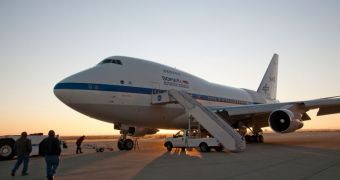Officials at NASA and the German Aerospace Center (DLR) announce that the Stratospheric Observatory for Infrared Astronomy (SOFIA) airborne observatory will soon receive a science instrument upgrade, which will make it more sensitive in its observations.
Through the addition of the High-resolution Airborne Wideband Camera (HAWC), scientists expect to allow the SOFIA user community access to a more sensitive, versatile and reliable imaging capability.
The instrument itself will feature two individual components, the High-resolution Airborne Wideband Camera Polarization (HAWC-Pol) and the HAWC++, according to the recent announcement.
Once the upgrades are installed, the airborne telescope will be able to measure both the structure and strength of the magnetic fields around a wide variety of objects in the Universe, at different distances from Earth. These objects range in size from stars and stellar nurseries to entire galaxies.
“SOFIA has the ability to become a world-class airborne observatory that complements the Hubble, Spitzer and Herschel space telescopes. This upgrade will greatly broaden SOFIA's capabilities,” explains the NASA Science Mission Directorate associate administrator, John Grunsfeld.
When it came to deciding on the second-generation instrument investigations that were to be installed on SOFIA, the American space agency had to analyze 11 proposals. The two that made the final cut were judged as having the potential to produce the highest scientific return.
HAWC-Pol will enable the telescope to “make polarimetric observations at far-infrared wavelengths. The investigation's main goals are to measure the magnetic field in the interstellar medium, star forming regions and the center of the Milky Way,” NASA reports.
The principal investigator for this proposal is Charles Dowell, from the Jet Propulsion Laboratory (JPL), in Pasadena, California.
The second proposal, HAWC++, will add a sensitive, large-format detector array to the HAWC-Pol investigation. This will increase the latter's observing efficiency, and provide a broader range of targets.
Johns Hopkins University (JHU) expert Johannes Staguhn is the principal investigator for this mission.
SOFIA is a heavily modified Boeing 747SP aircraft, which carried a 2.5-meter telescope on its side. It can conduct observations in the infrared portion of the electromagnetic spectrum from altitudes as high as 45,000 feet (13.700 meters).

 14 DAY TRIAL //
14 DAY TRIAL //